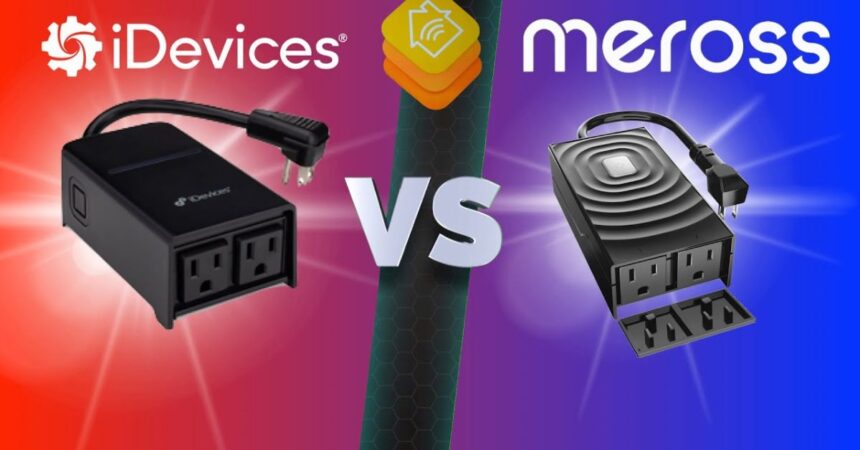The world of smart home automation is growing rapidly, and choosing the right system is crucial for a seamless experience. When comparing HomeKit device vs Meross LAN, the key factors to consider are internet dependency, compatibility, speed, security, and cost. In this article, we’ll dive deep into both options, providing unique insights, analyses, and recommendations to help you decide which system is the best fit for your smart home.
Introduction to HomeKit and Meross LAN
What is Apple HomeKit?
Apple HomeKit is a smart home ecosystem developed by Apple that allows users to control compatible devices using their iPhone, iPad, Apple Watch, or Mac. HomeKit devices are known for their seamless integration with Apple’s ecosystem, strong privacy features, and user-friendly interface.
What is Meross LAN?
Meross LAN is a smart home platform that offers local area network (LAN) control for its devices. Unlike many smart home systems that rely heavily on cloud services, Meross LAN allows users to control their devices without an internet connection, making it a popular choice for those who prioritize speed, reliability, and privacy.
Key Features and Benefits
Apple HomeKit: The Premium Smart Home Experience
- Seamless Integration: HomeKit works effortlessly with Apple devices, offering features like Siri voice control and automation through the Home app.
- Privacy and Security: HomeKit uses end-to-end encryption, ensuring that your data remains private and secure.
- Ecosystem Compatibility: HomeKit is compatible with a wide range of third-party devices, from smart lights to thermostats and security cameras.
Meross LAN: The Affordable, Reliable Alternative
- Local Control: Meross LAN devices can be controlled without an internet connection, making them faster and more reliable.
- Cost-Effective: Meross devices are generally more affordable than HomeKit-compatible devices, making them a great option for budget-conscious users.
- Wide Device Range: Meross offers a variety of smart home products, including smart plugs, light bulbs, and garage door openers.
HomeKit vs. Meross LAN: A Detailed Comparison
1. Internet Dependency
- HomeKit: While HomeKit can work locally with a Home Hub (Apple TV, HomePod, or iPad), many features require an internet connection for remote access and updates.
- Meross LAN: Meross LAN devices are designed to work entirely offline, making them ideal for users who want to minimize their reliance on the internet.
Insight: For users in areas with unreliable internet connectivity, Meross LAN offers a significant advantage. However, HomeKit’s cloud integration provides more flexibility for remote access.
2. Compatibility
- HomeKit: HomeKit is exclusive to Apple devices, which can be a limitation for Android users. However, it integrates well with other Apple services like Siri and iCloud.
- Meross LAN: Meross devices are cross-platform compatible, working with Alexa, Google Assistant, and SmartThings. While they are not natively HomeKit-compatible, some devices can be integrated with HomeKit using third-party apps like Homebridge.
Insight: If you’re deeply embedded in the Apple ecosystem, HomeKit is the obvious choice. However, Meross LAN’s cross-platform compatibility makes it a more versatile option for mixed-device households.
3. Speed and Performance
- HomeKit: HomeKit devices are known for their fast response times, especially when controlled locally via a Home Hub.
- Meross LAN: Since Meross LAN devices operate locally, they offer near-instantaneous response times, even without an internet connection.
Insight: Both systems perform well, but Meross LAN has a slight edge in speed due to its local-only operation.
4. Security and Privacy
- HomeKit: Apple’s commitment to privacy is evident in HomeKit’s end-to-end encryption, ensuring that your data is secure from hackers and third parties.
- Meross LAN: Meross LAN devices also prioritize security by operating locally, reducing the risk of cloud-based vulnerabilities. However, they lack the advanced encryption features of HomeKit.
Insight: HomeKit is the clear winner for users who prioritize privacy and security, while Meross LAN offers a good balance of security and convenience.
5. Cost
- HomeKit: HomeKit-compatible devices tend to be more expensive, reflecting Apple’s premium branding and advanced features.
- Meross LAN: Meross devices are significantly more affordable, making them an attractive option for users on a budget.
Insight: If cost is a major factor, Meross LAN provides excellent value without compromising on performance.
Pros and Cons
Apple HomeKit
Pros:
- Seamless integration with Apple devices.
- Strong privacy and security features.
- Wide range of compatible third-party devices.
Cons:
- Higher cost.
- Limited compatibility with non-Apple devices.
- Requires an internet connection for full functionality.
Meross LAN
Pros:
- Affordable pricing.
- Local control for faster performance.
- Cross-platform compatibility.
Cons:
- Lacks advanced security features.
- Not natively compatible with HomeKit.
- Limited ecosystem compared to HomeKit.
Use Cases and Recommendations
When to Choose HomeKit
- You are an Apple enthusiast with multiple Apple devices.
- Privacy and security are your top priorities.
- You want a premium, user-friendly experience.
When to Choose Meross LAN
- You need a budget-friendly smart home solution.
- You want local control for faster performance.
- You use a mix of different smart home platforms (e.g., Alexa, Google Assistant).
Trending FAQs
1. What is the main difference between HomeKit and Meross LAN in terms of compatibility with smart home ecosystems?
HomeKit is exclusive to Apple devices, while Meross LAN is cross-platform compatible, working with Alexa, Google Assistant, and SmartThings.
2. Can Meross LAN devices work with Apple HomeKit, or do they require additional setup?
Meross LAN devices are not natively HomeKit-compatible but can be integrated using third-party apps like Homebridge.
3. Which system offers better performance and reliability for smart home automation in the USA?
Both systems perform well, but Meross LAN has an edge in speed due to its local-only operation, while HomeKit offers better integration with Apple devices.
4. Are Meross LAN devices more affordable than HomeKit-compatible devices, and is the cost difference worth it?
Yes, Meross LAN devices are generally more affordable, making them a great option for budget-conscious users. However, HomeKit offers premium features that may justify the higher cost for some users.
5. How do HomeKit and Meross LAN compare in terms of privacy and data security for smart home users?
HomeKit uses end-to-end encryption, making it more secure, while Meross LAN prioritizes local control, reducing cloud-based vulnerabilities but lacking advanced encryption.
Conclusion
Choosing between HomeKit devices and Meross LAN ultimately depends on your specific needs, budget, and ecosystem preferences. If you’re an Apple user who values privacy, security, and seamless integration, HomeKit is the way to go. On the other hand, if you’re looking for an affordable, fast, and versatile smart home solution, Meross LAN is an excellent choice.
By understanding the key differences, pros, and cons of each system, you can make an informed decision that enhances your smart home experience. Whether you prioritize performance, cost, or compatibility, both HomeKit and Meross LAN offer unique advantages that cater to different user needs.





